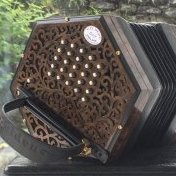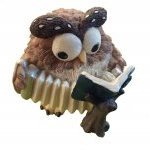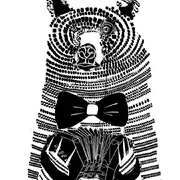-
Posts
580 -
Joined
-
Last visited
Little John's Achievements

Heavyweight Boxer (5/6)
-

1/4-comma meantone calculation for Anglos
Little John replied to Luke Hillman's topic in General Concertina Discussion
I would suggest D# and G#, for two reasons. Most players nowadays prefer the "sharp" keys over the "flat" keys. The Irish even refer to a C/G Anglo as a "D" instrument, because that's the key it's most commonly played in. Secondly, an Eb in a B major chord sounds dreadful, but D# in a C minor chord sounds acceptable. D# crops up a lot in Em tunes. -

1/4-comma meantone calculation for Anglos
Little John replied to Luke Hillman's topic in General Concertina Discussion
The chart shown doesn't indicate the note names. If this is based an a reference of A, as is stated, then: 2 (m2, -24 cents) is A#. A better choice might be Bb (+17.1 cents) 7 (T, -20.5 cents) is D#. Probably a good choice but if you prefer Eb it would be +20.5 cents. 9 (m6, -27.4 cents) is E#. A better choice would be F (+13.7 cents) There's a danger in trusting the computer to do what you want! -

EC tuning mystery solved....I think
Little John replied to Matthew Heumann's topic in Instrument Construction & Repair
That was my experience, too a few years ago. I'm a convert to mean tone tuning now. Evangelical, even! The most important thing to grasp about tuning temperaments is that they are all compromises. As you have observed, the big compromise with ET is that the thirds are sharp by about 14 cents. (An ET semitone is 100 cents. The 1/7 you mention is approximately 14/100 - 14 cents.) Pure intonation overcomes this, but the big compromise is that it only works in one key. You could tune a concertina to have a pure C major scale, but any other key will be wrong. The solution applied to concertinas (both English and Anglo) in the 19th century was quarter comma mean tone tuning*. This makes the major thirds pure. The fifths are little flat but that doesn't seem offensive. The main compromise is that it gives six good keys**, but six somewhat nasty sounding ones. [* if you stack four pure fifths (3:2) you get 81:16, which is the major third. Bring it down two octaves gives 81:64, which is approximately 1.266. This is greater than the 5:4 (=1.25) of the pure major third. The difference is called the syntonic comma. Since you've stacked four pure fifths to get this, the solution is to take a quarter of the syntonic comma off each fifth. The resulting major third is then pure, and the tuning is quarter comma mean tone.] [** Eight in the case of the English concertina, because of the two extra accidentals.] -

EC tuning mystery solved....I think
Little John replied to Matthew Heumann's topic in Instrument Construction & Repair
True, the gaps would look odd so filling them in is more aesthetically pleasing, but I think there's a more important reason for including them. The English system was devised with a logical consistency of fingering in mind: each accidental (sharp or flat) should be adjacent to its natural. This allows scales to be played alternating left-right for each note in turn. As there are seven naturals to the octave, that leaves space for seven accidentals, where a piano has only five; thus allowing for the "duplication" of two accidentals. Wheatstone chose to make these D#/Eb and G#/Ab, giving four sharps and three flats. If, say, the D# and Ab were omitted in theory (and assuming equal temperament tuning) the English concertina would still be fully chromatic; but the alternating left-right fingering would be lost for a couple of keys; for example E major, in which the passage C# D# E would have to be played as C# Eb E - all three consecutive notes on the same hand - thus breaking the fingering pattern. The English layout also means that a simple chord (a triad) can be formed on just one side of the instrument (i.e. all three notes are the same side, whether that's right or left), but again with (for example) the Ab missing an F minor chord would be split between the hands as F G# C - again breaking the pattern. The truth is that, if the English concertina had only 12 notes to the octave, then despite being fully chromatic it would be possible to play in only 6 keys while retaining the pattern of alternating hands for scales and the same hand for triads. Adding the extra two accidentals increases that to 8 keys; that is those between 3 flats and 4 sharps. You can still play in C# major (seven sharps) if you want but the consistent fingering patterns will be well and truly broken. Now if the English is tuned to a mean tone temperament the keys you can play in without breaking the consistent fingering patterns are exactly the same as those you can play in without encountering the wolf fifth. This is no coincidence. So if you stick to keys that retain the consistent fingering pattern you are also sticking to the keys that sound good in mean tone tuning, and vice versa. It's speculation, of course, but my bet would be that Wheatstone settled on the consistent fingering patterns first and then realised the ability to use mean tone tuning was an added bonus. -

F Tenor conversion - Why D# to Db?
Little John replied to 4to5to6's topic in Instrument Construction & Repair
Yes, for me the key determinant is the position of middle C. Middle of the left thumb strap = treble. Top of the left thumb strap = tenor. Above the right thumb strap = baritone. -

F Tenor conversion - Why D# to Db?
Little John replied to 4to5to6's topic in Instrument Construction & Repair
I would prefer to think of it as a discussion 😀. OK, so a treble with extra notes at the top (usually a 56-button) is often called an "extended treble", but it is definitely a treble by virtue of the position of the middle C and the fact that it starts from G3 (the G below middle C). If by "the full range of the treble" you mean 48 buttons, that is certainly the most common range now, but earlier Wheatstones had fewer buttons. What they all had is the middle C in the same position and a bottom note of G3. Modern makers have realised that most people have no use for the highest notes. Marcus music advertise an English concertina with 37 buttons. A C Norman advertises 32 and 20 button English concertinas. Wheatstone in their "Mayfair" period sold a 30 button English (Barleycorn have one for sale at the moment). They have fewer buttons than the "full" 48 button Treble, but in all respects they are a treble concertinas. What buttons they have you will find in exactly the same position as on a "full" treble. I suggest it is easier to refer to them as "37-button treble", "32-button treble" etc. rather than having a different name for each. The same logic applies to the "tenor-treble" (although someone, I forget who, pointed out that "treble-tenor" might be even more logical) because it is a treble instrument which has been extended downward to the tenor range. But it is first and foremost a treble because of the position of middle C. A player of the standard treble could pick it up and play without any adjustment. This is also what distinguishes a "baritone-treble" from a "baritone". Similar range of notes. A treble player could again pick up a baritone-treble and play in the normal treble range without adjustment. But not a baritone. They would find themselves sounding an octave lower than expected, and if they wanted to play at treble pitch the notes would all be in the wrong place. I think this is most unlikely. The reed slots would be too short to accommodate reeds a fifth lower, and the chambers would be too small for the pitch. The instrument in your photograph looks bigger than the standard 6 1/4" treble size; as indeed was the Crabb tenor I once had briefly on approval. (I didn't keep it because, for the price asked, it wasn't in very good condition.) -

F Tenor conversion - Why D# to Db?
Little John replied to 4to5to6's topic in Instrument Construction & Repair
Not everyone will agree with me, but my view is that if middle C is where it would be on a treble, and the range extends to the C below that, then the instrument is a tenor-treble; albeit truncated at the top end. Again in my view, the Crabb is a true tenor. It would be interesting to know if it started live as an F-tenor, but without looking inside it's impossible to get any clue. I can't really see the advantage of converting a TT to a not-quite F tenor; unless you want to play brass band music from an Eb score, which is what F-tenors were meant for. -

FOR SALE: 74 Button Hayden/Wicky Duet Concertina by Edward Jay
Little John replied to Kaleb's topic in Buy & Sell
Just out of interest, what is the new instrument you've ordered? Bigger, smaller, different in other ways? -

EFDSS looking a bit foolish.
Little John replied to Robin Madge's topic in General Concertina Discussion
I could be wrong, but I think the name was coined by Ian A Anderson in the Southern Rag days. Southern Rag became Folkroots (or Folk Roots?) which morphed into fRoots. -

EFDSS looking a bit foolish.
Little John replied to Robin Madge's topic in General Concertina Discussion
I remember it as "Dance Earnestly and Forget About Song Society" - DEFASS. Footnote: Some will not be aware that EFDSS - the English Folk Dance and Song Society - was generally referred to as "Effduss". -

EC tuning mystery solved....I think
Little John replied to Matthew Heumann's topic in Instrument Construction & Repair
The mystery to me is not that someone has done this to get a lower note, but that they chose to do it with the G# rather than the Ab. If Ab is lowered to F then F is on the side it should be, albeit not in the normal position. This seems much more natural, because (a) it maintains the alternating left-right fingering for scales and (b) it allows the F-C open fifth and the F major chord to be fingered all on one side, as normal. Choosing to lower G# suggests the players at the time valued Ab much more than G#. That would suggest it was done a long time ago since (as far as I know) sharp keys are much more popular than flat keys nowadays. -
That looks like R180 again. Have you taken out the reed pans to look on the inside? I had a Dipper until recently. I think (but I can't be certain) there was a number printed there in the form 092/85; 92 being the serial number and 85 the year of manufacture (1985). I would guess 180 is the serial number.
-

Choosing between small Maccanns
Little John replied to Bouleaux's topic in General Concertina Discussion
Another option I should have mentioned is to get a tuner/repairer to make two new reeds, or to source two old reeds pitched at D, to fit the existing chambers. Then Bouleaux could swap the reeds round for his/her self and experiment with no further pressure or cost.





